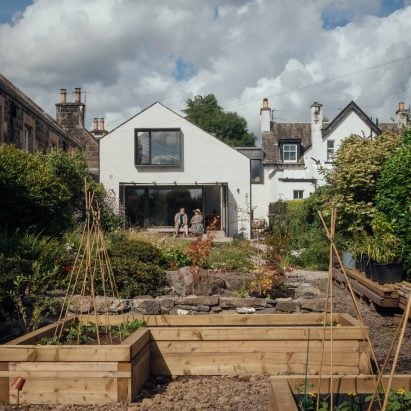Architecture studio Loader Monteith has renovated and extended an 18th-century cottage in Scotland, creating a series of open and accessible spaces for a resident living with Alzheimer’s disease.
Glasgow-based Loader Monteith renovated and extended the stone cottage in Perthshire, which was originally built in 1789, but had suffered years of neglect after being reconfigured into a dental surgery.
Loader Monteith has renovated and extended an 18th-century cottage in Scotland
Alongside the renovation of its structure, the cottage’s new owners tasked the studio with creating a “safe haven” for a member of the household with dementia.
This gave the project its name of Hameart – a Scots Gaelic word for homely.
“Hameart is very much about home and family, and how architecture can help support and celebrate these familial connections,” Loader Monteith director Matt Loader told Dezeen.
“It was incredibly important to both clients and us that the house was comfortable, with a warmth in the materials selected throughout.”
Hameart was designed to be a “safe haven” for a resident with dementia
The compartmentalised layout of the existing cottage has been opened up by relocating its staircase from the front to the rear of the home and replacing a poor-quality extension with a two-storey volume housing an additional bedroom.
This reconfiguration created a clear axis through the centre of the home that connects three distinct areas – the original cottage facing the street, a kitchen and patio at the centre and a living and dining area overlooking the garden and River Earn beyond.
Its interior was opened up to be more dementia-friendly
“The original plan was very long and thin; we wanted to break the house into three separate ‘areas’ to ensure that there was no sensation of being in a corridor at any point,” said Loader.
“We wanted to connect inside to outside in the back two-thirds of the house, with the original cottage, with its low ceilings and smaller window openings, respected and celebrated.”
This layout, as well as the home’s internal fittings, were all intended to make the home more dementia-friendly, including the removal of doors to the kitchen and living areas, fitted shelving throughout and a sitting area and tea prep on the landing.
Similarly, a simple material palette was selected to bring a feeling of warmth, with white walls and ceilings, a mixture of tiled, timber and carpeted floors and pale timber carpentry, including a slatted screen alongside the staircase.
White walls and carpentry are used throughout the home
On the first floor, a new en-suite bedroom sits beneath the pitched ceilings of the extension, with a large projecting window overlooking the garden.
Externally, the extension has been finished in rough textured render, while a projecting metal opening that surrounds the living and dining room’s sliding glass doors has been finished with a perforated pattern based on the names of the client’s grandchildren.
A new bedroom sits within the first-floor extension
Matt Loader founded Loader Monteith alongside Iain Monteith in 2016.
Previous projects by the studio include a home in Angus that “honours rural Scottish architecture” and a larch-clad Learning Hub outside Edinburgh designed in collaboration with Studio SJM.
The photography is by Jim Stephenson.
The post Loader Monteith renovates 18th-century Scottish cottage to be a “safe haven” appeared first on Dezeen.
